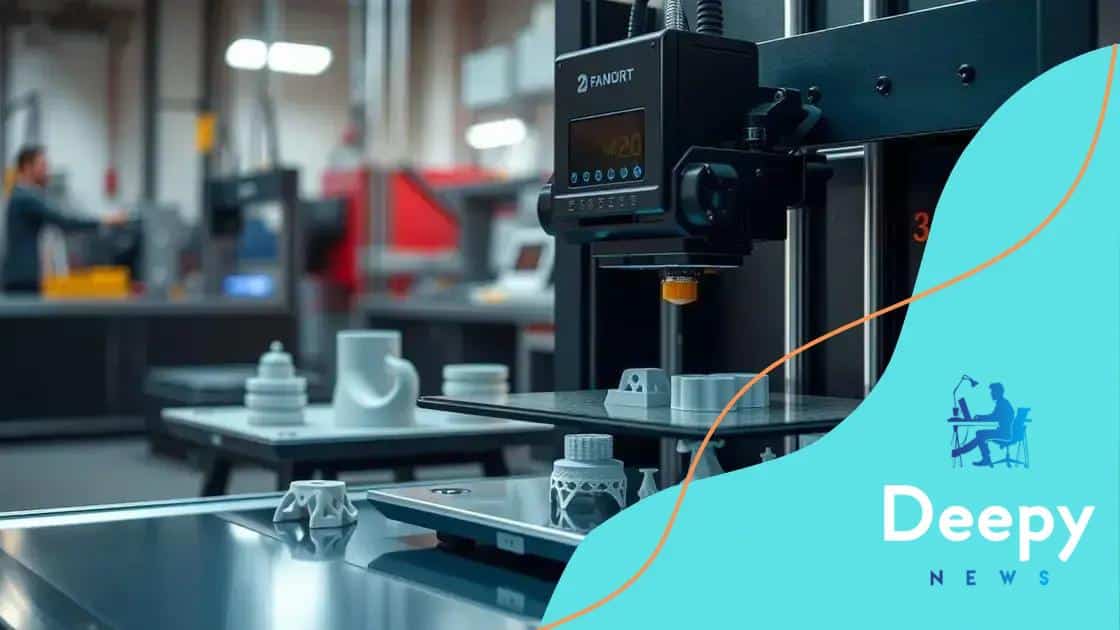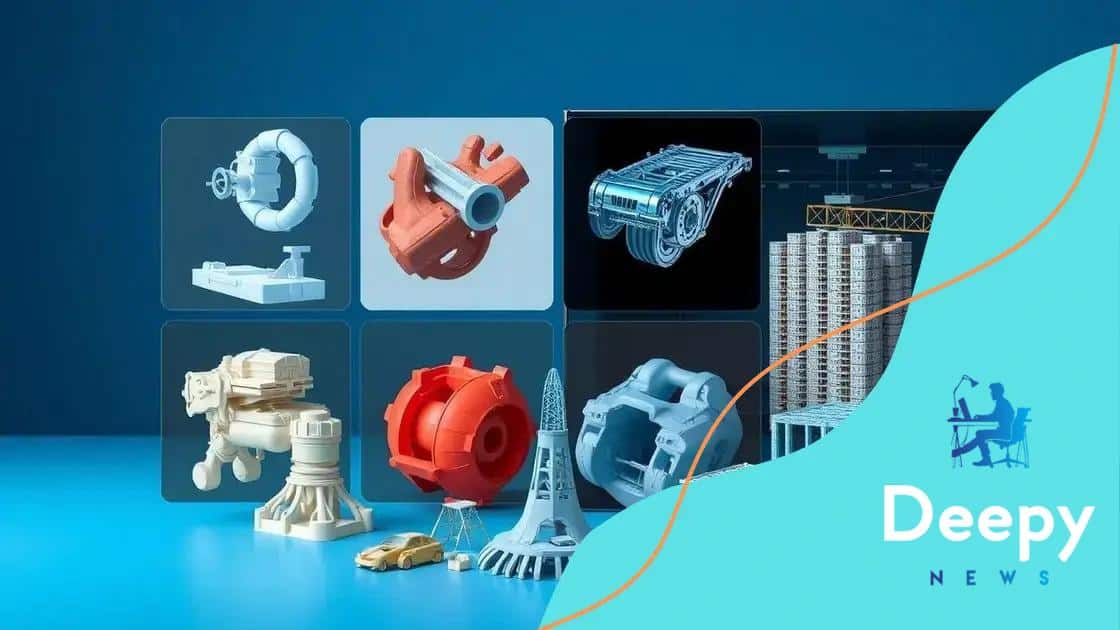The growing impact of 3D printing in manufacturing

The growing impact of 3D printing in manufacturing is evident through its ability to enhance efficiency, enable customization, and reduce costs across various industries like healthcare, aerospace, and automotive.
The growing impact of 3D printing in manufacturing is transforming traditional processes. Have you ever wondered how this technology could simplify your production line or enhance creativity in design? Let’s delve into its influence!
Understanding 3D printing technology
Understanding 3D printing technology is essential for manufacturers looking to innovate. This technology creates three-dimensional objects by layering materials, giving businesses the flexibility to produce complex designs efficiently.
How 3D Printing Works
At its core, 3D printing begins with a digital model. This model is sliced into thin, horizontal layers by slicing software. Once sliced, the printer builds the object layer by layer, using materials like plastics, metals, and even biological substances. This method allows for unprecedented customization and rapid prototyping.
Types of 3D Printing
There are several types of 3D printing technologies, each suitable for different applications:
- Fused Deposition Modeling (FDM) – This is one of the most common methods, using a thermoplastic filament that is heated and extruded.
- Stereolithography (SLA) – This technique uses a laser to cure liquid resin into solid plastic, ideal for high-detail items.
- Selective Laser Sintering (SLS) – It uses a laser to fuse powdered materials, creating durable and complex parts.
Understanding these methods can help manufacturers choose the right approach for their needs. Each technology offers distinct advantages based on the materials used and the final product’s required properties. Also, the speed of production can vary, allowing for flexibility in manufacturing processes.
3D printing is not just a trend; it’s a revolution in manufacturing that offers benefits such as reduced waste and lower production costs. It allows companies to bring ideas to life faster than traditional methods. As businesses continue to adopt this technology, those who grasp its potential will gain a significant competitive edge.
Key benefits for manufacturers
Key benefits for manufacturers using 3D printing technology are transforming the way products are developed and produced. This innovative approach allows for efficiency, customization, and a reduction in waste, helping businesses stay competitive in a fast-paced market.
Efficiency and Speed
One of the most significant advantages is the ability to produce items quickly. Traditional manufacturing can be time-consuming, especially with prototyping. 3D printing significantly reduces the time from design to production.
Cost Reduction
Another benefit is the reduction in costs. By minimizing material waste, manufacturers can save money. Also, fewer machines and less labor are required when using 3D printers. This streamlining leads to overall cost savings.
- Lower material costs – 3D printing uses only the necessary amount of material.
- Reduced production time – Faster turnaround allows for more products in less time.
- Minimized labor needs – Automation reduces the reliance on manual labor.
Customization is another vital aspect. With 3D printing, manufacturers can easily adjust designs to meet specific customer needs without dramatically increasing costs. This flexibility allows businesses to lower lead times and improve customer satisfaction.
Furthermore, 3D printing enables greater innovation. Manufacturers can prototype and test designs rapidly, allowing them to explore new ideas and products. This ability can lead to enhanced creativity and faster innovation cycles. Using this technology can lead to a significant competitive advantage.
Real-world applications of 3D printing

Real-world applications of 3D printing are expanding across various industries, demonstrating the versatility and power of this technology. From healthcare to aerospace, the impact is significant.
Healthcare Innovations
In healthcare, 3D printing is revolutionizing patient care. Medical professionals can create custom prosthetics and implants tailored to individual patients. This customization improves fit and comfort, leading to better outcomes.
Aerospace and Automotive
Aerospace and automotive industries also benefit greatly. Companies use 3D printing for prototyping new parts, which accelerates the design process and reduces costs. Parts can be produced on demand, minimizing inventory needs.
- Lightweight components – 3D printing allows for the creation of parts that are both strong and lightweight, enhancing fuel efficiency.
- Complex geometries – Manufacturers can produce intricate designs that would be impossible with traditional methods.
- Rapid prototyping – Quick development of prototypes gives engineers the ability to test and iterate faster.
Additionally, 3D printing has made its way into the fashion industry. Designers can create unique clothing and accessories with precision. This technology allows for intricate patterns and shapes that were previously challenging to achieve.
Another exciting use is in construction, where 3D printing is redefining how buildings are constructed. Large-scale printers can fabricate entire structures, reducing construction time and costs.
As more sectors adopt this technology, the applications continue to grow. 3D printing not only enhances efficiency but also encourages innovation, leading to groundbreaking products and services.
Challenges and limitations in 3D printing
Challenges and limitations in 3D printing can impact how businesses adopt this technology. While it offers many advantages, it also poses some obstacles that manufacturers must consider.
Material Limitations
One major challenge is the range of materials available for 3D printing. Many 3D printers are limited to specific substances, which can restrict design choices. For example, while plastics are widely used, options for metals and composites can be more limited and costly.
Speed and Scale
Another limitation is the speed of production. Although 3D printing is faster than traditional methods for prototyping, mass production can still be slow. This means that businesses needing to produce large quantities may find it challenging to rely solely on 3D printing.
- Time-consuming setup – Preparing for printing can take time and resources.
- Production rate – Fewer items can be produced in a shorter time compared to conventional methods.
- Material costs – Some materials may be expensive, affecting overall costs.
Quality consistency can also be an issue. The printing process can vary, leading to inconsistencies in the final product. Factors such as temperature, humidity, and printer calibration can affect outcomes, making quality control a concern.
Furthermore, regulatory hurdles exist, especially in industries like healthcare and aerospace. Complying with safety standards requires extensive testing and validation of 3D-printed items. This can delay the time it takes to bring products to market.
Despite these challenges, ongoing advancements in 3D printing technologies aim to address these limitations. As the industry grows, solutions are being developed to make this process more efficient and reliable.
Future trends in 3D printing
Future trends in 3D printing are shaping the landscape of manufacturing and design. As technology advances, we can expect exciting developments that will impact many industries.
Increased Material Variety
One significant trend is the expansion of materials available for 3D printing. Innovations in material science are leading to new types of plastics, metals, and even biological materials that can be printed. This will open doors for creating more complex and durable products.
Speed and Efficiency Improvements
Another trend is the enhancement of printing speed and efficiency. As printers become faster and more reliable, they will be able to produce larger quantities of products quickly. This could revolutionize the way businesses manage supply chains and reduce inventory costs.
- Multi-material printing – The ability to print with multiple materials simultaneously will allow for complex items with varying properties.
- Automation and AI – Integrating artificial intelligence in 3D printing processes will streamline operations and improve precision.
- Eco-friendly practices – As sustainability becomes a priority, we may see more biodegradable materials being used in 3D printing.
Customization will also be a significant focus as consumers demand more personalized products. With 3D printing, businesses can easily create unique items tailored to individual preferences, enhancing customer satisfaction.
Furthermore, advancements in bioprinting are on the horizon, potentially allowing for the creation of organs and tissues for medical use. This technology could lead to breakthroughs in healthcare and regenerative medicine.
As the industry evolves, collaborative efforts among manufacturers, researchers, and technology developers will fuel these trends. The future of 3D printing holds endless possibilities, making it an exciting time for innovation.
FAQ – Frequently Asked Questions about 3D Printing
What are the main benefits of 3D printing for manufacturers?
3D printing offers benefits like reduced costs, faster prototyping, and the ability to create customized products tailored to customer needs.
What challenges do manufacturers face with 3D printing?
Manufacturers may encounter challenges such as material limitations, slow production speeds, and quality consistency issues.
How is 3D printing used in healthcare?
In healthcare, 3D printing is used to create custom prosthetics and implants designed specifically for individual patients, improving comfort and fit.
What future trends can we expect in 3D printing?
Future trends include expanded material options, increased printing speeds, greater customization, and advancements in bioprinting for medical applications.






